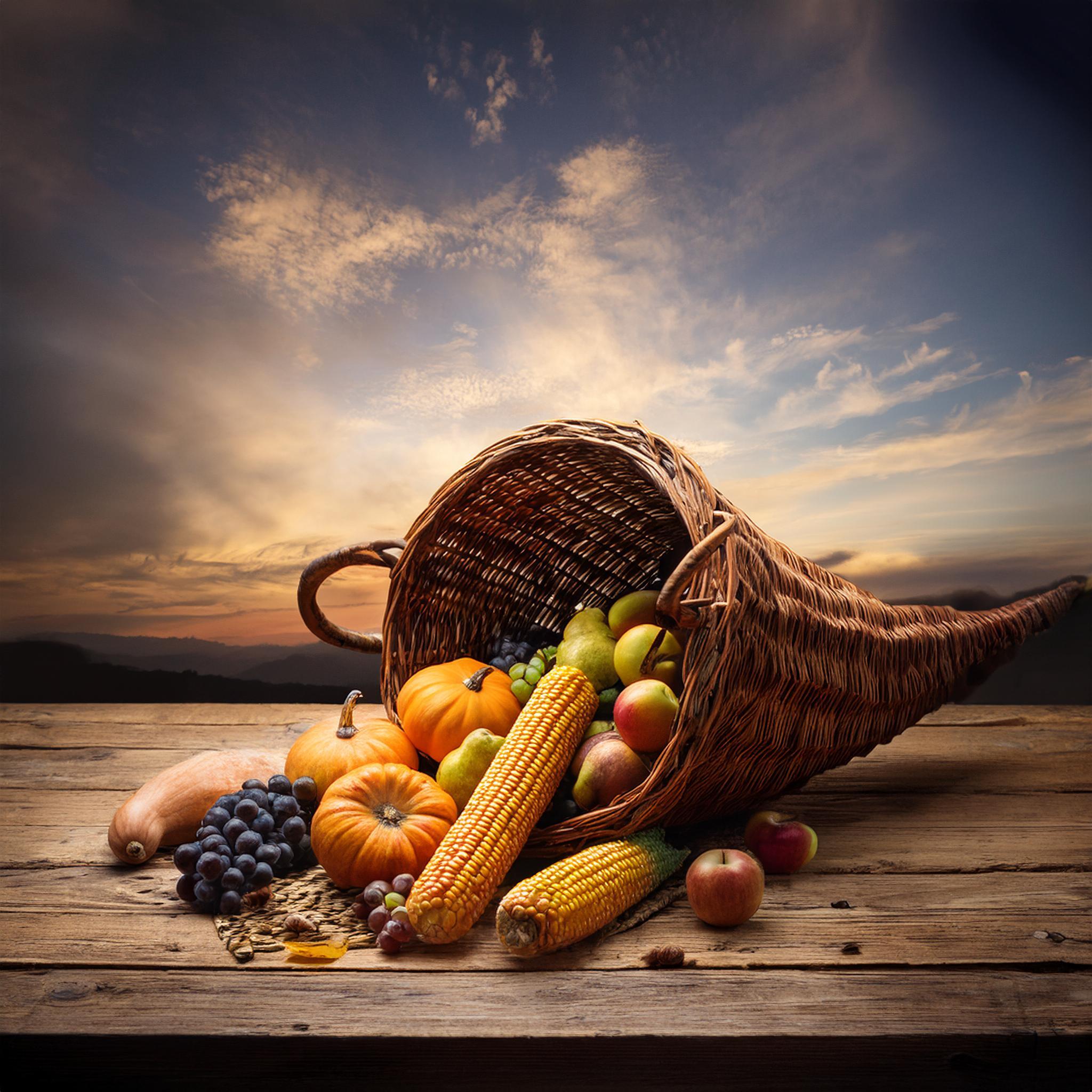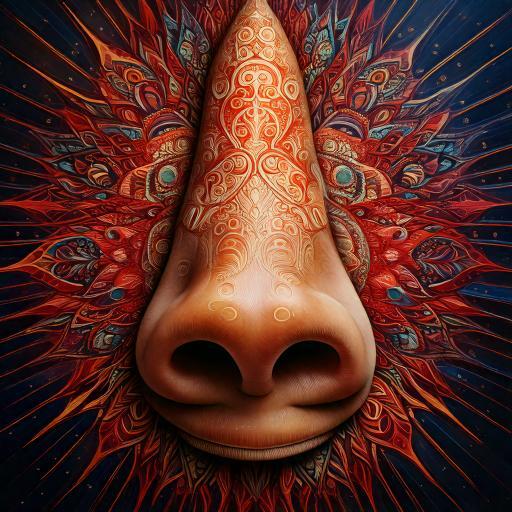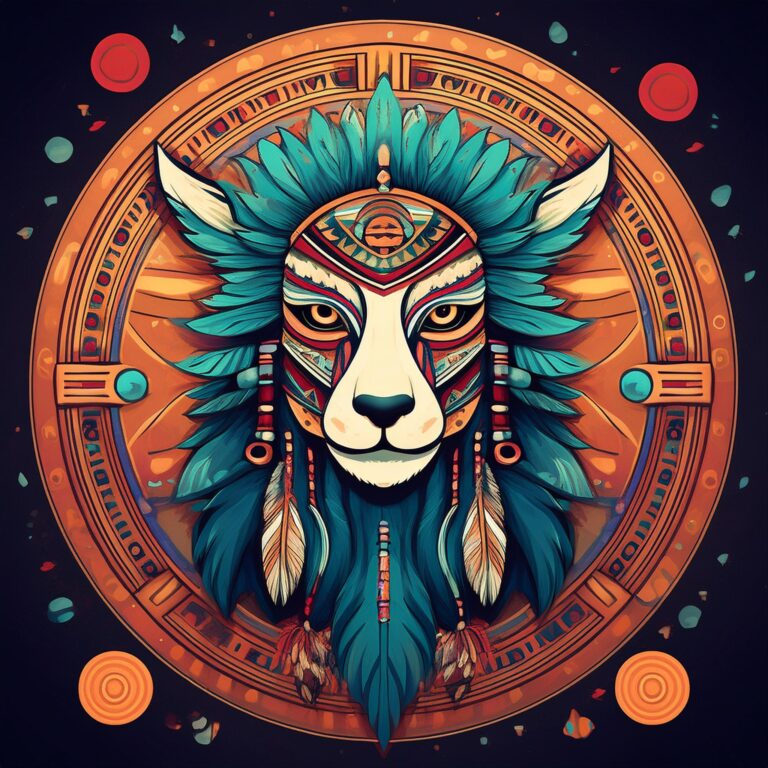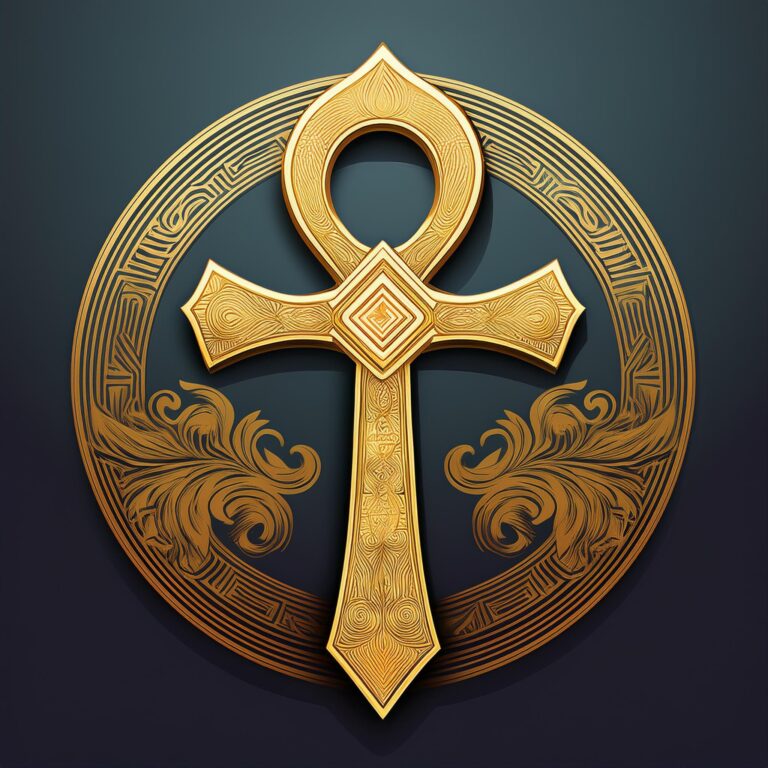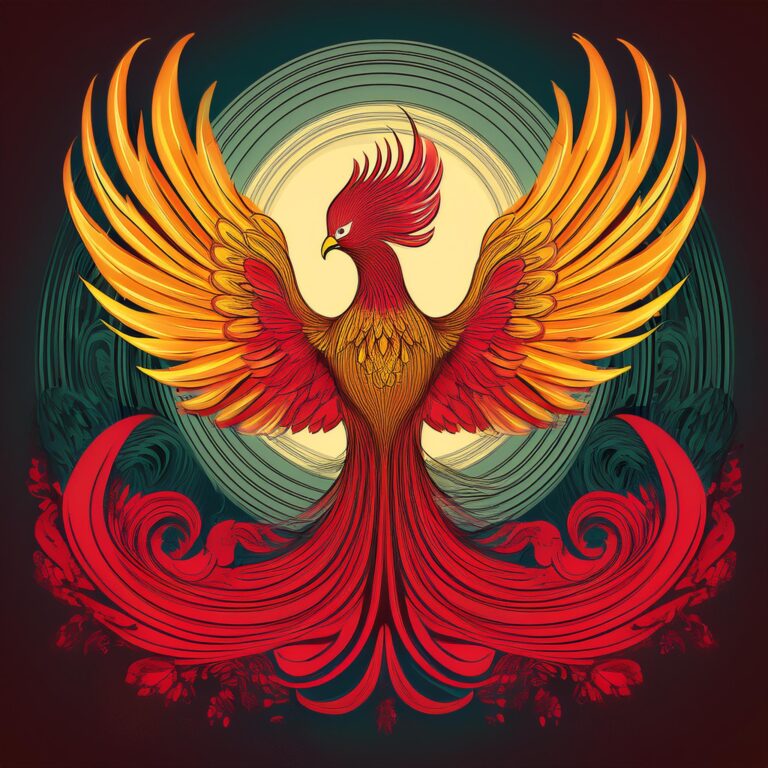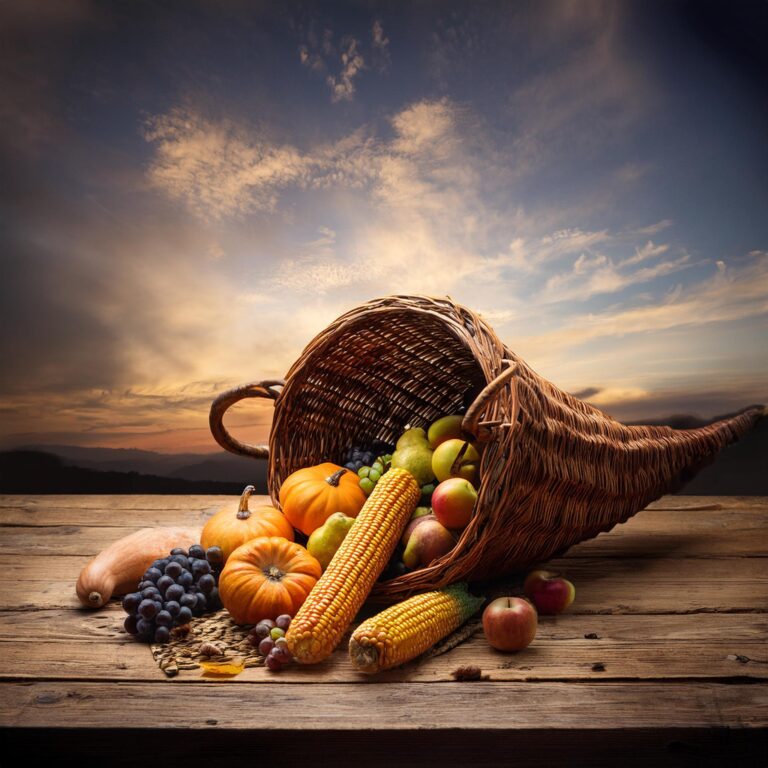The cornucopia, often referred to as the “Horn of Plenty,” is a symbol deeply rooted in mythology, representing abundance, nourishment, and prosperity. Its iconic shape—a curved, hollow horn overflowing with fruits, flowers, and other offerings—has made it a powerful emblem across various cultures and epochs.
The origins of the cornucopia trace back to ancient Greece, where it is most famously associated with the myth of the infant Zeus and the nurturing goat, Amalthea. According to legend, the cornucopia was a magical horn that could endlessly provide whatever its holder desired. This mythological background established the cornucopia as a symbol of boundless generosity and wealth.
Over time, the cornucopia has transcended its mythological beginnings to become a universal symbol of plenty. It frequently appears in art, literature, and celebrations, particularly during harvest festivals like Thanksgiving in the United States. Here, it is often depicted as a centerpiece overflowing with the season’s bounty, reinforcing its association with gratitude and the fruitful harvest.
The cornucopia’s symbolism extends beyond material wealth, often representing spiritual and emotional abundance as well. Whether in classical art or modern interpretations, the cornucopia continues to embody the ideals of prosperity, generosity, and the fulfillment of both physical and spiritual needs.
The Origins of the Cornucopia
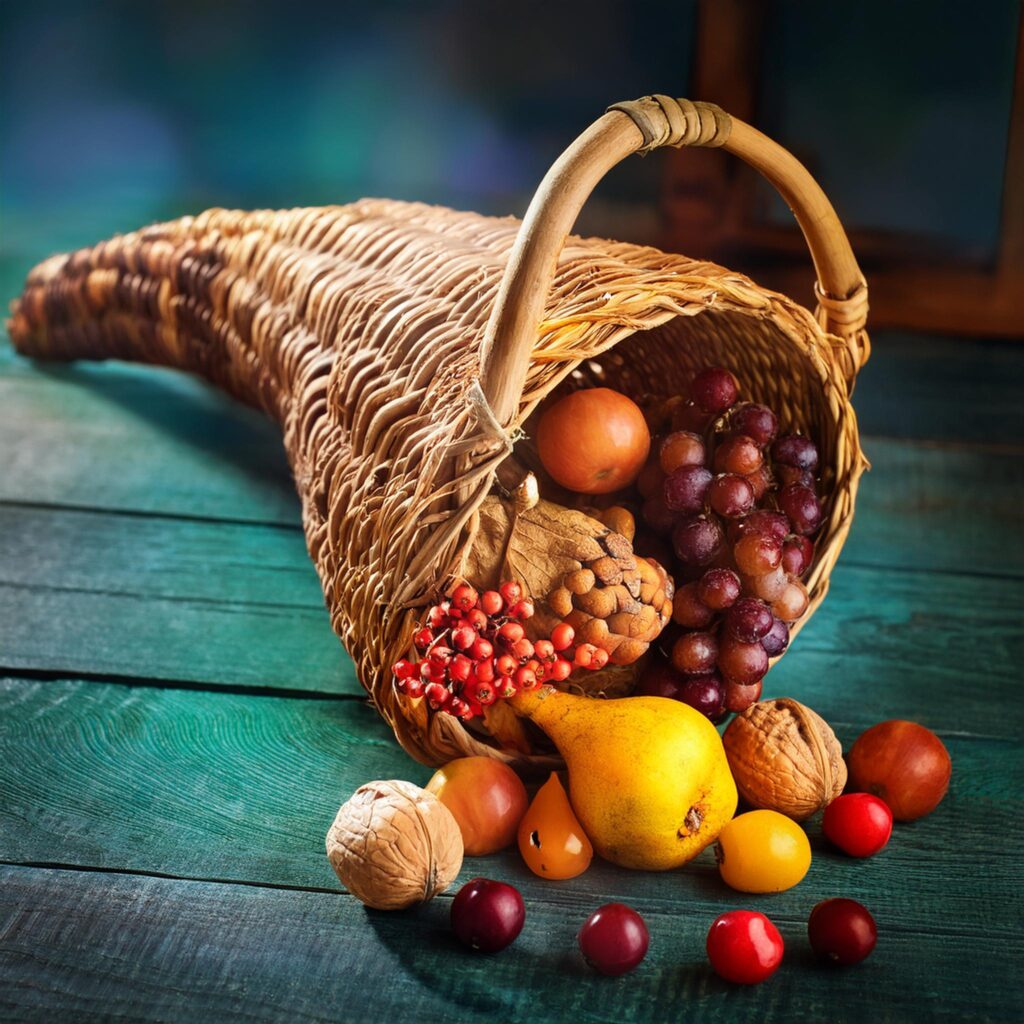
The origins of the cornucopia are steeped in ancient mythology, with its earliest references found in Greek and Roman traditions. The term “cornucopia” itself comes from the Latin words “cornu” meaning “horn” and “copia” meaning “plenty,” perfectly encapsulating its essence as a symbol of abundance.
In mythology, the cornucopia is often associated with divine nourishment, as seen in the legend of Zeus, whose goat foster mother, Amalthea, provided him with endless sustenance. Over time, the cornucopia evolved into a broader emblem of prosperity and harvest, frequently depicted overflowing with fruits, grains, and flowers. Beyond its role in representing wealth and abundance, the cornucopia has also come to be recognized as a symbol for hope, promising continued prosperity and the fulfillment of future needs.
One of the most well-known myths surrounding the cornucopia is the story of Amalthea, the nurturing goat who cared for the infant Zeus, the king of the gods in Greek mythology. According to legend, Amalthea provided Zeus with milk, and in gratitude, he blessed one of her horns with the power to produce an endless supply of food and drink. This magical horn, known as the cornucopia, became a symbol of divine nourishment and endless bounty.
Another version of the myth suggests that Zeus accidentally broke off one of Amalthea’s horns during a playful encounter. He then endowed the horn with miraculous powers, making it a source of unlimited wealth and sustenance. This mythological tale underscores the idea of the cornucopia as a symbol of generosity and unending provision.
The cornucopia also appears in Roman mythology, where it is associated with various deities, including Fortuna, the goddess of fortune, and Ceres, the goddess of agriculture. For these deities, the cornucopia symbolized the abundance of the earth, prosperity, and the well-being of humanity.
As the symbol spread across different cultures, it retained its association with nourishment and wealth. In ancient Rome, the cornucopia was often depicted in sculptures, mosaics, and coins, signifying the prosperity of the empire and the generosity of its rulers.
The enduring legacy of the cornucopia can be seen in its continued use in modern times, where it remains a powerful symbol of abundance and gratitude, particularly during harvest festivals and other celebrations of plenty. Its rich mythological origins have made it a timeless emblem, representing the universal desire for prosperity and well-being.
The Symbolism of the Cornucopia
The cornucopia, or “Horn of Plenty,” carries deep symbolic meaning that has resonated through various cultures and historical periods. At its core, the cornucopia represents abundance and prosperity, symbolizing a bountiful harvest, wealth, and the nourishment of both body and soul.
In its earliest representations, the cornucopia was associated with the divine provision of food and sustenance. This connection to nourishment made it a powerful emblem of fertility and the earth’s capacity to provide for humanity. The overflowing horn, brimming with fruits, grains, and flowers, encapsulates the idea of nature’s generosity, offering more than enough to meet the needs of all.
Beyond its physical symbolism, the cornucopia also embodies spiritual abundance. It is often seen as a metaphor for the richness of life, encompassing not only material wealth but also the abundance of love, health, happiness, and wisdom. This duality—representing both the tangible and intangible aspects of prosperity—has made the cornucopia a versatile symbol across different contexts.
In ancient Greece and Rome, the cornucopia was closely linked to deities of agriculture and fertility, such as Demeter and Ceres. These goddesses were often depicted holding or surrounded by cornucopias, reinforcing their roles as providers of life-sustaining resources. The symbol served as a reminder of the gods’ favor and the importance of gratitude for the earth’s bounty.
As the cornucopia spread through different cultures, it retained its association with abundance but also took on additional meanings. In art, literature, and religious iconography, the cornucopia has been used to represent the idea of divine favor and the promise of eternal plenty. It often appears in depictions of paradise, where it symbolizes the unending abundance of the afterlife.
In modern times, the cornucopia is most commonly associated with Thanksgiving and other harvest festivals, where it symbolizes gratitude for the year’s bounty. It is a reminder of the importance of acknowledging the sources of our prosperity and sharing our wealth with others.
The cornucopia’s enduring symbolism of abundance and generosity continues to resonate, making it a timeless emblem of prosperity, gratitude, and the interconnectedness of all forms of wealth—material, spiritual, and communal.
The Cornucopia in Art and Literature
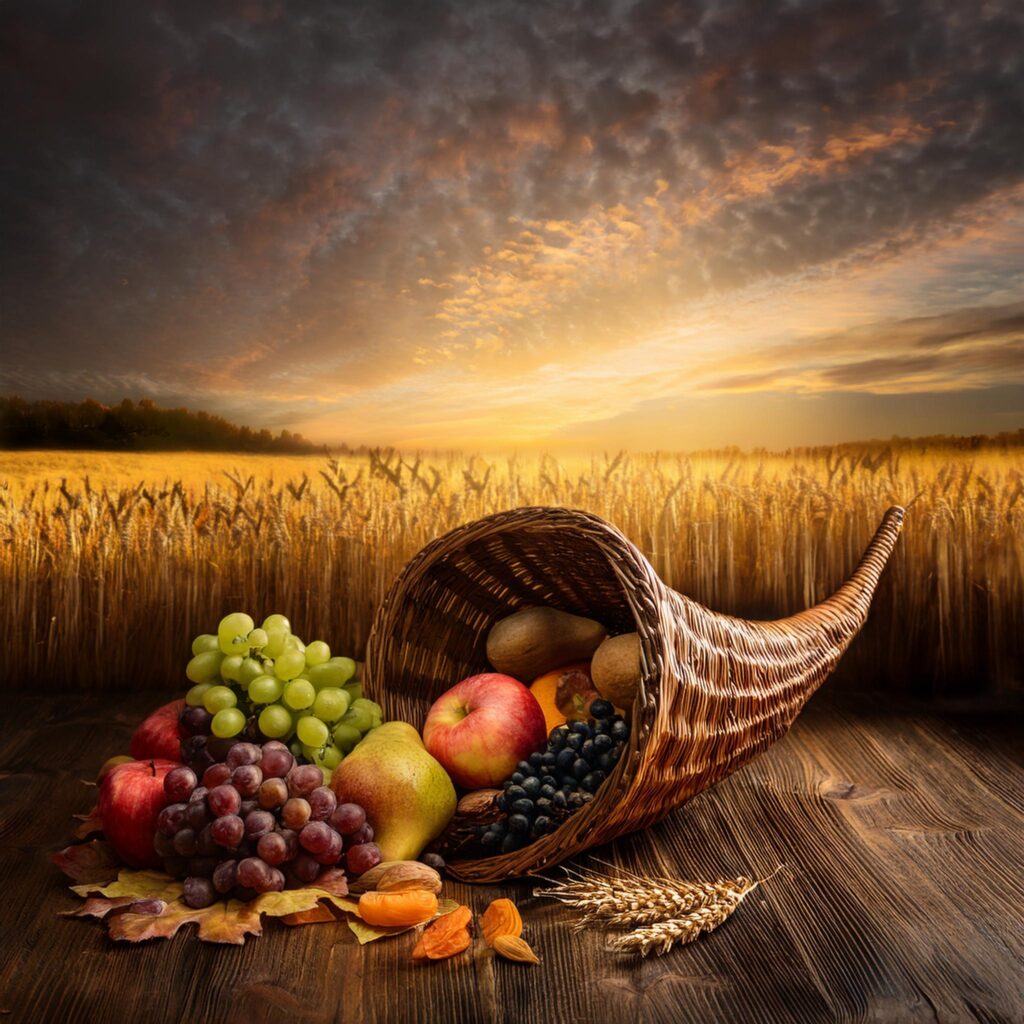
The cornucopia has been a prominent symbol in art and literature for centuries, serving as a powerful representation of abundance, prosperity, and the nurturing aspects of nature. Its distinctive form—a horn overflowing with fruits, flowers, and other symbols of plenty—has inspired artists and writers to explore themes of wealth, gratitude, and the bountiful gifts of the earth.
In classical art, the cornucopia often appears in sculptures, paintings, and mosaics, particularly in the context of mythology and religion. Ancient Greek and Roman artists frequently depicted gods and goddesses, such as Demeter, Ceres, and Fortuna, holding or surrounded by cornucopias. These deities, associated with agriculture, fertility, and fortune, used the cornucopia to symbolize their divine power to provide for humanity. The image of the cornucopia in these works reinforced the idea of divine abundance and the earth’s capacity to sustain life.
During the Renaissance, the cornucopia became a popular motif in European art, symbolizing the revival of classical ideals and the celebration of human achievement. Artists like Peter Paul Rubens and Albrecht Dürer incorporated cornucopias into their works, often in allegorical contexts, where the horn of plenty represented not only material wealth but also the flourishing of culture, knowledge, and creativity. In these depictions, the cornucopia was often accompanied by other symbols of prosperity, such as sheaves of wheat, overflowing baskets, and bountiful harvests.
In literature, the cornucopia has been used as a metaphor for abundance and generosity, appearing in various genres ranging from poetry to prose. In epic poetry and classical texts, the cornucopia often symbolizes the favor of the gods and the prosperity of nations. Writers used the image of the overflowing horn to evoke the richness of life and the endless possibilities of a world blessed with natural and spiritual wealth.
In modern literature, the cornucopia continues to symbolize plenty, though its meanings have expanded to include a broader range of interpretations. It can represent the bounty of nature, the rewards of hard work, or the richness of human experience. For example, in works that explore themes of gratitude and thanksgiving, the cornucopia serves as a reminder of the importance of recognizing and celebrating the abundance in our lives.
The cornucopia’s presence in art and literature underscores its enduring significance as a symbol of prosperity, fertility, and the nurturing aspects of nature. Whether depicted in a classical sculpture, a Renaissance painting, or a modern literary work, the cornucopia remains a timeless emblem of the bountiful gifts that life has to offer.
The Cornucopia in Modern Times
In modern times, the cornucopia has retained its status as a symbol of abundance and prosperity, continuing to be a significant motif in various cultural, artistic, and commercial contexts. Although its roots lie in ancient mythology, the cornucopia has evolved to represent not only agricultural bounty but also broader concepts of wealth, generosity, and gratitude in contemporary society.
One of the most prominent examples of the cornucopia’s enduring relevance is its association with Thanksgiving in the United States. During this holiday, the cornucopia often serves as a centerpiece in festive displays, symbolizing the harvest and the blessings of the year. It is typically depicted as a wicker basket shaped like a horn, overflowing with seasonal fruits, vegetables, nuts, and flowers. This modern interpretation of the cornucopia reflects the holiday’s focus on giving thanks for the abundance of food and the comfort of family and community.
Beyond its use in holiday traditions, the cornucopia also appears in various forms of popular culture, from advertising to public art. Companies often use the cornucopia in their branding and marketing to convey ideas of plenty and richness. For example, food and beverage brands might incorporate the cornucopia into their logos or packaging to suggest that their products are wholesome and abundant, drawing on the symbol’s connotations of natural wealth and nourishment.
In public art and civic symbolism, the cornucopia continues to be a powerful emblem. It is often used in seals, emblems, and sculptures to represent prosperity and the well-being of communities. For instance, many state and municipal seals in the United States feature the cornucopia, emphasizing the idea of economic and agricultural abundance as foundational to the region’s identity and success.
Moreover, the cornucopia has found a place in the digital age, where it is sometimes used as a metaphor for the seemingly limitless possibilities offered by technology and innovation. In this context, the cornucopia can represent the vast potential of resources and opportunities that modern advancements make available, echoing its traditional symbolism of endless provision.
In literature and the arts, contemporary creators continue to explore and reinterpret the cornucopia’s symbolism. Modern artists might depict the cornucopia in abstract forms or as part of installations that comment on issues such as consumerism, sustainability, and the environment. Writers, too, use the cornucopia as a metaphor for the richness of human experience, drawing on its historical associations while infusing it with new meanings relevant to today’s world.
The cornucopia’s adaptability and rich symbolism ensure that it remains a relevant and powerful symbol in modern times. Whether as a traditional icon of the harvest, a symbol of community prosperity, or a metaphor for the abundance of opportunities in the digital age, the cornucopia continues to inspire and resonate across a wide range of cultural expressions.
The Cornucopia in Various Cultures
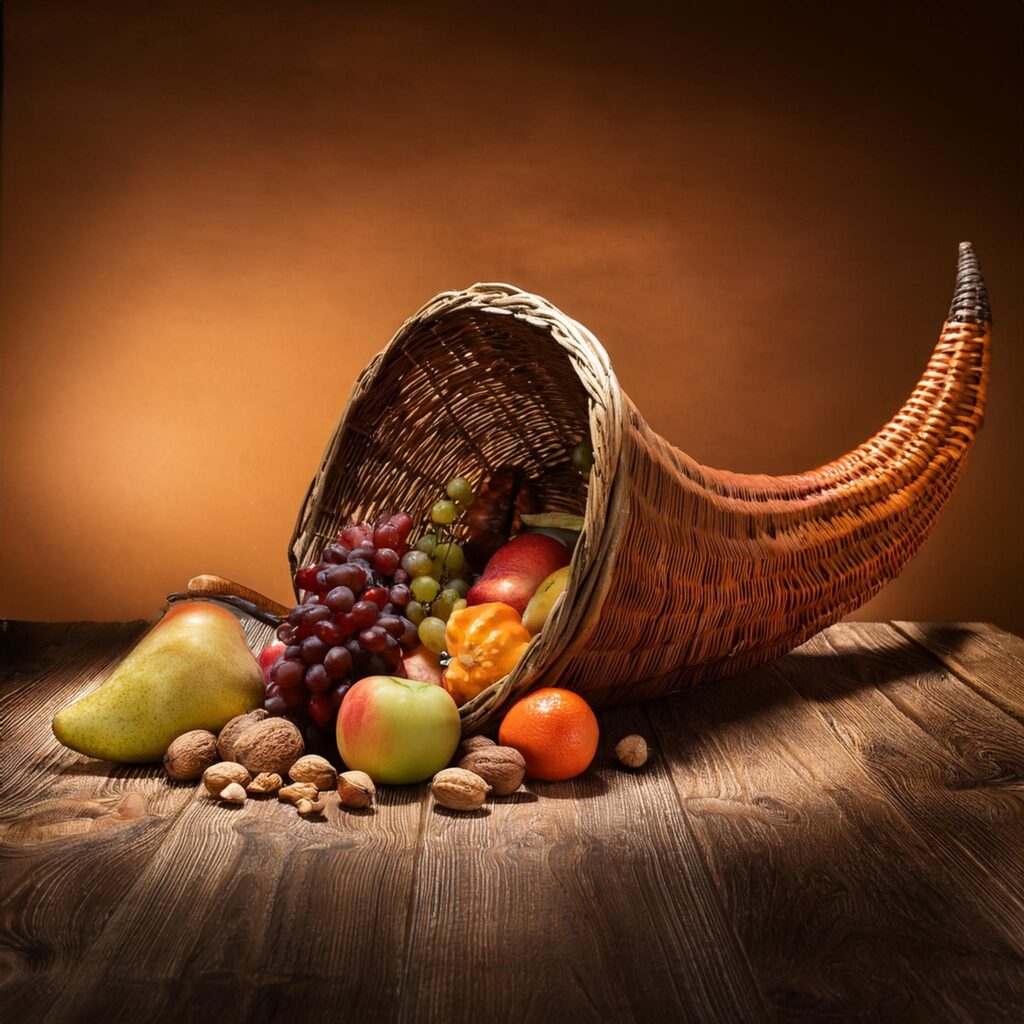
The cornucopia, or “Horn of Plenty,” is a symbol that has transcended its ancient origins, finding significance in a variety of cultures around the world. Though its most well-known associations are with Greek and Roman mythology, the cornucopia’s symbolism of abundance and nourishment has been embraced and reinterpreted by diverse civilizations, each adding their unique cultural nuances to this iconic symbol.
In ancient Greece and Rome, the cornucopia was closely tied to agricultural deities and the natural world. In Greek mythology, it was linked to the nurturing goat Amalthea, whose horn provided Zeus with endless sustenance. In Roman culture, the cornucopia became associated with goddesses like Fortuna, who symbolized fortune and prosperity, and Ceres, the goddess of agriculture. For the Romans, the cornucopia represented not only the bounty of the harvest but also the blessings of the gods and the wealth of the empire.
As the Roman Empire expanded, the symbol of the cornucopia spread across Europe, where it was absorbed into various local traditions. In medieval Europe, the cornucopia was often used in Christian art and symbolism, where it took on a spiritual dimension. It was depicted as a symbol of divine grace and the Church’s ability to provide spiritual nourishment to its followers. This interpretation emphasized the cornucopia’s role as a source of not just material abundance, but also moral and spiritual well-being.
In Indigenous cultures of the Americas, the concept of a “horn of plenty” also found resonance, particularly in agricultural societies that revered the earth’s fertility. Although the cornucopia as a physical object was not part of these cultures, the idea of an abundant harvest and the earth’s generosity was central to many Native American spiritual practices and festivals. Corn, beans, squash, and other staple crops were often celebrated as gifts from the Earth Mother, paralleling the cornucopia’s symbolism of bountiful provision.
In modern Western cultures, particularly in the United States, the cornucopia has become a ubiquitous symbol of Thanksgiving and harvest celebrations. During Thanksgiving, the cornucopia is used as a decorative motif, often filled with autumnal produce such as pumpkins, gourds, apples, and corn. This modern interpretation is rooted in the holiday’s themes of gratitude and abundance, linking the cornucopia to a season of giving thanks for the year’s harvest and the prosperity of the community.
In Eastern cultures, while the cornucopia as a specific symbol is less common, similar concepts of abundance and prosperity are represented in other ways. For instance, in Chinese culture, the “ruyi,” a scepter-like object, symbolizes good fortune and the fulfillment of wishes. The idea of plenty is also embodied in the imagery of overflowing wealth vases and the “bowl of plenty,” which are often depicted in Chinese art as symbols of wealth and prosperity.
The cornucopia’s ability to adapt to different cultural contexts speaks to its universal appeal as a symbol of abundance and well-being. Whether in the context of ancient mythology, religious symbolism, or modern-day celebrations, the cornucopia continues to represent the timeless human desire for prosperity, nourishment, and the generosity of the natural world.
Cornucopia as a Symbol of Abundance
The cornucopia, universally known as the “Horn of Plenty,” stands as one of the most enduring symbols of abundance. Its iconic image—a horn overflowing with fruits, vegetables, grains, and flowers—represents the idea of limitless bounty and the earth’s capacity to provide sustenance. This powerful symbolism has resonated across cultures and time periods, making the cornucopia a quintessential emblem of prosperity and plenty.
At its core, the cornucopia embodies the concept of abundance in the most literal sense. Its origins in Greek mythology, where it was linked to the nurturing goat Amalthea, highlight its association with nourishment and the nurturing aspects of nature. In this myth, the cornucopia provided an endless supply of food, emphasizing the idea of unceasing provision and the earth’s fertility. This association with nourishment and sustenance has made the cornucopia a natural symbol for agricultural abundance, particularly during harvest festivals.
Beyond its agricultural connections, the cornucopia also represents a broader sense of abundance—one that encompasses wealth, prosperity, and the flourishing of life in all its forms. The horn’s overflowing nature suggests not just enough to survive, but an excess, a surplus that can be shared and celebrated. This aspect of the cornucopia as a symbol of wealth and prosperity can be seen in its depiction alongside deities such as Fortuna, the Roman goddess of fortune, who is often shown holding a cornucopia to signify her ability to bestow riches and good fortune upon those she favors.
In art and literature, the cornucopia often appears in scenes celebrating the harvest, prosperity, and the rewards of hard work. It serves as a reminder that abundance is the result of both the earth’s generosity and human effort. In this sense, the cornucopia is not just a passive symbol of plenty, but also a dynamic one that reflects the relationship between nature and humanity—the way in which human beings cultivate, harvest, and benefit from the earth’s resources.
In modern times, the cornucopia has retained its association with abundance, particularly in the context of Thanksgiving and other harvest-related celebrations. It is used as a decorative motif, often filled with the season’s produce, symbolizing the wealth of the harvest and the community’s collective prosperity. The cornucopia’s continued presence in these traditions underscores its role as a symbol of gratitude for the abundance that sustains life.
Moreover, the cornucopia can also be seen as a metaphor for spiritual abundance. It represents the idea that life offers a multitude of gifts—whether material, emotional, or spiritual—and that true wealth lies in recognizing and appreciating these gifts. This spiritual dimension of the cornucopia speaks to its timeless appeal, as it encourages a mindset of gratitude and generosity.
The cornucopia’s enduring symbolism as a representation of abundance highlights its relevance across various contexts, from ancient mythology to contemporary celebrations. Whether symbolizing the earth’s bountiful harvest, the prosperity of a community, or the richness of the human spirit, the cornucopia remains a powerful emblem of the many forms of abundance that life has to offer.
The Cornucopia in Popular Culture
The cornucopia, with its rich history and symbolism, has seamlessly woven itself into the fabric of popular culture, becoming a widely recognized emblem of abundance, prosperity, and the harvest. Its influence can be seen across various forms of media, from movies and television shows to advertising and public events, where it often represents both literal and metaphorical plenty.
In film and television, the cornucopia frequently appears in settings that emphasize themes of wealth, harvest, or celebration. One of the most prominent modern references to the cornucopia is in “The Hunger Games” series, where it takes on a more ominous role. In the dystopian world of Panem, the Cornucopia is a central structure in the arena, filled with weapons and supplies that the contestants, or “tributes,” must fight over to survive. This darker interpretation subverts the traditional meaning of the cornucopia, turning a symbol of life and abundance into one of conflict and survival. Despite this twist, the use of the cornucopia in “The Hunger Games” reinforces its association with resource allocation, even in a more sinister context.
In advertising, the cornucopia is often used to evoke feelings of plenty, comfort, and natural goodness. Food and beverage companies frequently incorporate cornucopias into their branding to suggest that their products are wholesome, bountiful, and derived from nature’s best offerings. For example, a grocery store or food brand might feature a cornucopia in their logo or packaging during the autumn season to highlight the freshness and variety of their produce, tying their image to the idea of a generous harvest.
The cornucopia also plays a significant role in holiday decorations, particularly around Thanksgiving in the United States and Canada. It is commonly used as a centerpiece, filled with autumnal produce like pumpkins, gourds, apples, and ears of corn. This usage ties back to the cornucopia’s historical roots as a symbol of the harvest and reflects the holiday’s emphasis on giving thanks for the year’s bounty. In this context, the cornucopia has become a cultural shorthand for the ideas of gratitude, family, and the celebration of nature’s gifts.
In public art and monuments, the cornucopia is often incorporated into sculptures and civic symbols to represent prosperity and the well-being of the community. Many state and municipal seals in the United States feature the cornucopia, signifying the region’s agricultural wealth and economic stability. Its inclusion in these symbols reflects the cornucopia’s long-standing role as a representation of communal abundance and the collective efforts that contribute to it.
Furthermore, in modern consumer culture, the concept of a cornucopia is sometimes used metaphorically to describe any source of plentiful or diverse offerings. For example, a “cornucopia of choices” might describe a marketplace or service that provides an extensive variety of options, echoing the idea of an overflowing horn filled with goods. This metaphorical usage highlights the cornucopia’s continued relevance as a symbol of variety and plenty in the contemporary world.
Through its appearances in film, television, advertising, and public symbols, the cornucopia continues to resonate as a potent image of abundance in popular culture. Whether symbolizing the harvest, the richness of consumer choices, or the wealth of natural resources, the cornucopia remains a powerful and versatile symbol that connects the ancient ideals of prosperity and nourishment with the values and narratives of the modern world.
Reader-Requested Symbols Related to the Cornucopia
In exploring the rich symbolism of the cornucopia, many readers have expressed interest in learning about other symbols that share thematic connections with this iconic emblem of abundance. These symbols, while distinct in their own right, often overlap with the cornucopia in their representation of prosperity, nourishment, and the bounty of nature. Here are a few symbols that readers frequently inquire about, highlighting their connections to the cornucopia:
1. The Sheaf of Wheat
The sheaf of wheat is a powerful symbol of the harvest and agricultural abundance, much like the cornucopia. In many cultures, wheat has been a staple crop, representing sustenance and the cycle of life. The sheaf of wheat symbolizes the earth’s capacity to provide and the importance of hard work in reaping nature’s rewards. Its connection to the cornucopia lies in its shared representation of the fruits of the earth and the nourishment they provide.
2. The Harvest Moon
The Harvest Moon, the full moon closest to the autumn equinox, has long been associated with the harvest season and the gathering of crops. It symbolizes completion, fulfillment, and the abundance of the earth as it reaches its peak of productivity. Like the cornucopia, the Harvest Moon serves as a reminder of nature’s generosity and the cyclical nature of life and growth.
3. The Corn Stalk
Corn, a staple crop in many cultures, especially in the Americas, is often depicted in its mature form as a stalk laden with ears of corn. The corn stalk symbolizes fertility, growth, and the sustenance provided by the earth. In many indigenous cultures, corn is revered as a sacred gift from the gods, and the corn stalk stands as a testament to the earth’s ability to provide for its people. Its association with the cornucopia is rooted in the shared symbolism of agricultural bounty and nourishment.
4. The Grapevine
The grapevine, with its clusters of grapes, is another symbol closely related to abundance and prosperity. In classical mythology, it is often associated with Dionysus (Bacchus), the god of wine, fertility, and festivity. The grapevine represents not only the wealth of the harvest but also the joy and celebration that comes with abundance. Its lush, fruitful imagery complements the overflowing nature of the cornucopia, reinforcing themes of richness and plenty.
5. The Apple
The apple is a symbol that appears in many cultural contexts, often representing fertility, knowledge, and prosperity. In various myths and religious traditions, apples are associated with divine gifts and the promise of abundance. The apple’s connection to the cornucopia lies in its frequent inclusion in depictions of the horn of plenty, where it represents one of the many fruits that symbolize nature’s generous offerings.
These symbols, requested by readers, enrich our understanding of the cornucopia by highlighting its thematic connections to other emblems of abundance. Each symbol contributes to a broader narrative of prosperity, nourishment, and the interconnectedness of life, echoing the timeless message of the cornucopia as a symbol of the earth’s boundless gifts.
Symbols Similar to the Cornucopia
The cornucopia, with its rich symbolism of abundance and prosperity, shares thematic connections with several other symbols across different cultures. These symbols, while distinct, often represent similar ideas of fertility, nourishment, and the bounty of nature. Below is a comparison of the cornucopia with several similar symbols, highlighting their origins, meanings, and cultural significance.
| Symbol | Origin | Meaning | Cultural Significance |
|---|---|---|---|
| Cornucopia | Ancient Greek and Roman mythology | Abundance, prosperity, and nourishment | Symbol of the harvest and divine provision, often depicted overflowing with fruits, grains, and flowers. |
| Sheaf of Wheat | Various agricultural societies | Harvest, fertility, and sustenance | Represents the gathering of crops and the earth’s ability to sustain life, often used in religious and cultural rituals. |
| Horn of Ammon | Ancient Egyptian and Greek mythology | Strength, fertility, and life force | Linked to the god Ammon, symbolizing power and the life-giving force of nature. |
| Grapevine | Classical mythology, particularly Greek | Fertility, abundance, and festivity | Associated with Dionysus/Bacchus, symbolizing the joy of harvest and the richness of life, often depicted with grapes. |
| Harvest Moon | Various cultures, notably East Asian | Completion, fulfillment, and the peak of productivity | Represents the time of harvest, symbolizing the abundance of crops and the cycle of life. |
| Corn Stalk | Indigenous cultures of the Americas | Fertility, growth, and nourishment | Revered as a sacred plant, symbolizing the earth’s capacity to provide sustenance, central to many agricultural rituals. |
| Apple | Various cultural myths and religious texts | Fertility, knowledge, and divine gifts | Often seen as a symbol of prosperity and the earth’s abundance, frequently appearing in myths about divine generosity. |
Analysis of Similar Symbols
Each of these symbols, like the cornucopia, embodies the idea of plenty and the earth’s capacity to sustain life. While the cornucopia is often directly associated with the harvest and the overflowing bounty of nature, symbols like the sheaf of wheat or the grapevine emphasize specific aspects of agricultural abundance. The corn stalk and the Harvest Moon highlight the cyclical nature of life and the importance of timing in reaping nature’s rewards.
The cornucopia’s symbolism is broad, encompassing not just material wealth but also spiritual and communal prosperity. Similarly, the apple and the Horn of Ammon carry dual meanings, often representing both physical and metaphysical aspects of abundance. The diversity of these symbols across cultures and their recurring themes of fertility and prosperity underscore the universal human desire for sustenance and the celebration of nature’s gifts.
In summary, while the cornucopia is a unique symbol of abundance, its essence is shared by many other cultural symbols that together weave a rich tapestry of meanings related to life, growth, and the earth’s enduring generosity.
FAQ about the Cornucopia
The cornucopia, also known as the “Horn of Plenty,” is a symbol rich in history and meaning. Below are some frequently asked questions (FAQ) about the cornucopia, offering insights into its origins, symbolism, and cultural significance.
The cornucopia originates from ancient Greek and Roman mythology. According to Greek myth, the cornucopia was created from the horn of the goat Amalthea, who nourished the infant Zeus. The horn was said to provide an endless supply of food and drink, symbolizing abundance and nourishment. In Roman culture, the cornucopia became associated with deities like Fortuna and Ceres, who represented fortune and agriculture, respectively.
The cornucopia symbolizes abundance, prosperity, and the bounty of nature. It is often depicted as a horn-shaped basket overflowing with fruits, vegetables, and grains, representing the earth’s capacity to provide for humanity. The cornucopia is also a symbol of thanksgiving and gratitude, particularly in the context of harvest festivals.
In modern times, the cornucopia is commonly associated with Thanksgiving celebrations in the United States and Canada. It is often used as a decorative centerpiece filled with seasonal produce, symbolizing the harvest and the blessings of the year. The cornucopia also appears in art, literature, and public symbols, representing wealth, abundance, and the fruits of hard work.
Yes, several symbols share thematic similarities with the cornucopia. These include the sheaf of wheat, the grapevine, the corn stalk, and the Harvest Moon. Each of these symbols represents aspects of abundance, fertility, and the earth’s capacity to sustain life, much like the cornucopia.
While the cornucopia is primarily associated with Greek and Roman mythology, the concept of a “horn of plenty” resonates in various cultures worldwide. For example, the idea of abundance and fertility is represented in other symbols, such as the “ruyi” in Chinese culture, which symbolizes prosperity and fulfillment, and the corn stalk in Indigenous American cultures.
Traditionally, a cornucopia is made from a woven wicker or straw basket, shaped into a horn. This horn is then filled with an assortment of fruits, vegetables, nuts, and flowers. In modern decorative settings, cornucopias may also be made from ceramic, metal, or other materials, but they still retain the classic horn shape and are filled with harvest-themed items.
The horn shape of the cornucopia originates from its mythological roots, where it was said to be the horn of Amalthea, the goat who nurtured Zeus. The horn’s shape also symbolizes the idea of an overflowing vessel, where the narrow end represents the source of plenty, and the wide, open end allows for the endless flow of abundance.
Yes, the cornucopia is often used metaphorically to describe any source of abundance or an overflowing supply of resources. For example, one might refer to a “cornucopia of opportunities” to describe a situation with many available choices, emphasizing the idea of plentiful and diverse offerings.
The cornucopia is frequently used in public art, emblems, and seals, particularly in the United States. It often symbolizes prosperity and the well-being of a community. For instance, many state seals feature the cornucopia to represent agricultural wealth and the economic stability of the region.
You can incorporate a cornucopia into your celebrations, particularly during harvest festivals or Thanksgiving, by using it as a decorative centerpiece. Fill a horn-shaped basket with an assortment of seasonal fruits, vegetables, nuts, and flowers to symbolize abundance and gratitude. This tradition not only adds to the festive atmosphere but also serves as a reminder of the blessings of the season.

I’m the editor at SymbolsSays, where I explore the deeper meanings of symbols in mythology, art, literature, and psychology. My goal is to provide insights into how symbols influence our lives and connect us to our past.
